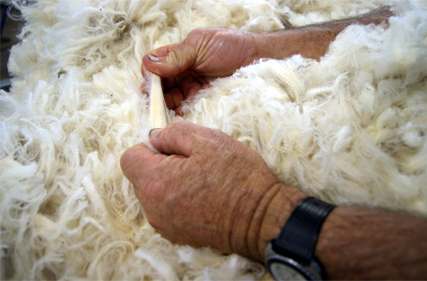 THE AWEX EMI rose 10c to 1578c at auction sales in Australia last week.
THE AWEX EMI rose 10c to 1578c at auction sales in Australia last week.
The early market intelligence had most players anticipating a weaker opening, with a general consensus that we may experience a 20-30c fall in the EMI.
The market opened slightly cheaper on Wednesday, however by the second half of the selling roster, new confidence emerged into the bidding.
Thursday’s market delivered a very positive result for the sellers with prices in the merino MPG’s pushing up 10-45c in the northern region and stretching the gap between some corresponding southern MPG’s.
Note the northern 17MPG is 104c above its southern equivalent.
This weeks mixed message could have been due to the 1.35c fall in the AUD/USD exchange rate as we saw the EMI in USD fall 13c, but however you wrap it, the market for merino types is very bullish emerging into the 5th month of sales with over $1b of wool sold to date – a vale in time not seen for 15 years.
Best style, fine and well measured lots attracted extreme competition whilst all other fleece types seemed to be well supported.
Skirtings were also well supported with the super fine low VM lots attracting extreme bidding.
Merino cardings added another 30c to their steady upward trend, with extreme buying pressure evident on the locks, stains and crutchings. Unfortunately the crossbred market continued to fall in value with falls of 20-35c on the 26-28 microns with the 29-31 categories generally holding last week’s levels.
Next week the market offers 47,266 bales across all centres, and we will be hoping for the exchange rate to remain low to allow this market to flourish. This is an extraordinary market environment.
Michael Avery from Southern Aurora Wool reports – The auction market opened with all microns losing ground on Wednesday only to rebound immediately of the back of better off shore interest and a weaker Australian Dollar.
This left both sides of the forward markets perplexed. Buyers were keen to start the week bidding to “cash” through to Christmas recess.
Sellers were hesitant taking this as a positive sign for the weeks ahead. The auction retreated on inaction offshore and some forward business was executed prior to buyers reducing levels. Fine wool growers were able to hedge at 2000 for 18.5 for November and December.
Strong forward prices were achieved in the New Year albeit on light volume. 18.5 traded in May at 1960 and 21.0 February at 1530 and March 1520. For the 21.0 micron grower this is locking in around $2000 a bale.
A brief analysis of prices over the first three months of the selling season shows all merino indices have had a range of around 140 cents or around 7 percent.
Current prices send a mixed message 18.0 and 19.0 are towards the top of their bands, 18.5 around the middle and 21.0 micron on the low end of their seasonal band.
All are still sitting at the 95 percentile on the 7 year figures. This presents a compelling argument for hedging in this environment.
Against this is the fact that, with the advantage of hindsight, forward hedging has been unnecessary in a market that trended up for almost 2 years. The current volatility would indicate it is prudent to reduce some exposure to price risk at this time.
~ Marty Moses
